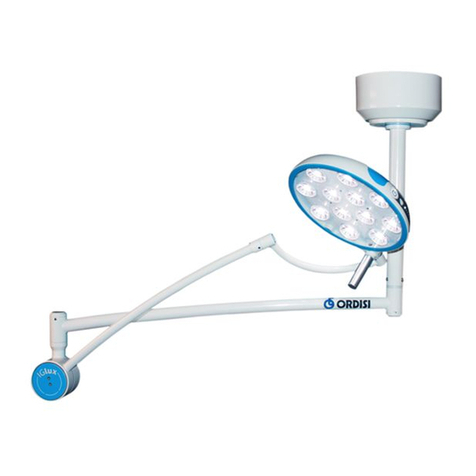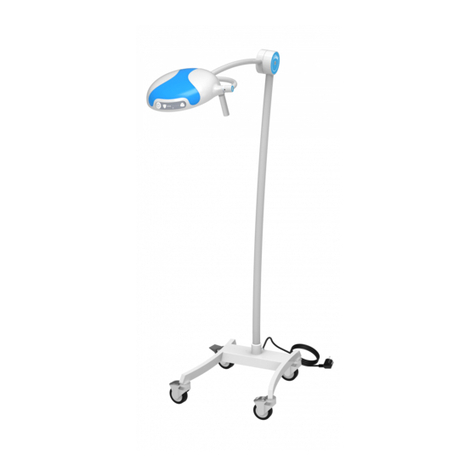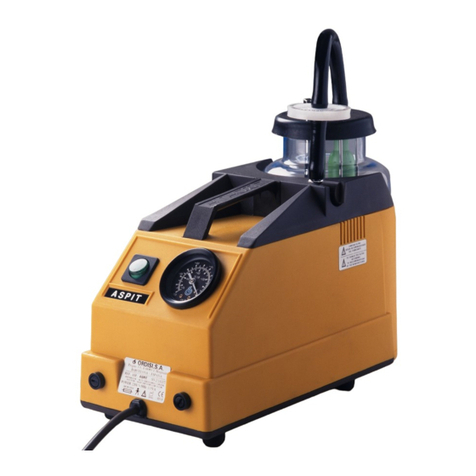Page 4of 10
4.- INSTALLATION AND OPERATING
4.1.- UNPACKING
Upon reception of the equipment, if package is seen as damaged, immediately check if device has been affected. If
damages are confirmed, immediately refer them to sender.
4.2.- START-UP
Not to use in explosive atmospheres like the anaesthetic produced ones by inflammable.
1) Check the electrical installation of the room where the equipment is being installed, and make sure it complies with the
IEC (UNE) regulations. Installations should have a proper earth connection as well as a correct voltage (noted in the
specs plate). Place the aspirator in the best suitable location of the room; making sure that the distance between the
aspirator and the walls of the room is at least 15 cm.
2) With the aspirator, you will find a aspiration set for a single use, (GRAVE RISK OF INFECTION IF USED IN
DIFFERENTS PATIENTS) composed by 2 meters of bulb tube, and one cannula that is connected to an extreme of the
tube. Enter the other extreme of the tube in the patient connector Nº 23 (to see point 2 section 4.3), indicated in the
bottle plug, and turn on the equipment. The cannula adds a regulatory hole, and through digital pressure may regule
the aspiration level. References for new orders: US0114020 bulb tube with cannula (20 units)
3) Vacuum regulator (No. 2) makes it possible to increase or to decrease vacuum level.
4) Vacuum gauge (No. 3) will indicate, at all times, the vacuum level that is received by the patient, (tolerance ±1.6%). It
is recommended that in normal conditions, the calibration of the vacuum-gauge is made once every two years.
5) The FV series vacuum cleaners are intended to be used in temperatures ranging between 15ºC and 35ºC
and a relative humidity of less than 70%. And at 1bar pressure.
4.3.- SUGGESTED USE
1) WARNING: Avoid filling the collection bottle beyond 80% of its capacity, as overflowing and fluids entry into the
pump may occur if the collection bottle is overfilled. Should this happen, we recommend disassembling and cleaning of
the pump head by the authorised technical service.
2) Do not use extremely long suction tubes as they tend to bend and collapse blocking the suction process. On another
note, there is a risk of the formation of bends in which aspirated substances may build up, producing a possible source
of contagion and infection. Periodically replace the tube of aspiration by a specific tube for this one assignment (it must
take to noticeable CE of conformity fulfilling the norm UNE EN 1617 of drainage tubes). Verify when replacing these
and before coming to the aspiration that the connection is watertight and flights do not take place. We recommended
the use of the following tubes of aspiration:
- PVC tube minimum inner diameter 6 mm by 9 mm of outer diameter.
- Silicone tube minimum inner diameter 6 mm by 10 mm of outer diameter.
- Evitar que el paciente se apoye en los tubos de aspiración, de forma que obstruya la misma.
3) After each use, the cap (No. 22), safety valve (No. 28) and bottle must be cleaned and sterilised
4) Do not start the aspirator if there is vacuum in the circuit. Before turning it on, bring vacuum level to 0.
5) The use of a reputable antifoaming agent should be considered as to avoid foam inside the bottle hindering a correct
filling read out.
6) Never connect any device, such as ventilators, aerosol generators, etc. to the air vent.
7) If the bottle is overfilled and the safety valve (No.28) is engaged, the machine will stop suctioning. Stop the aspirator
using the switch, bring the vacuum level to 0 by using the vacuum regulator (No.2) and change or empty the bottle.
8) The biological risk waste will be removed following the protocol of the hospital waste management.






























